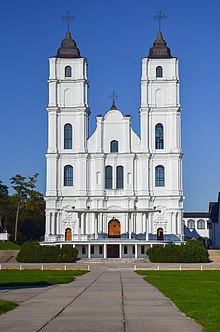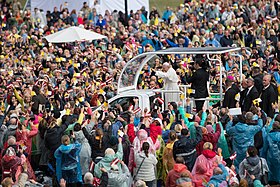
Demographic features of the population of the historical territory of Latvia include population density, ethnic background, education level, health of the populace, economic status, religious affiliations and other aspects of the population.

Dievturība is a modern continuation of the ethnic religion of the Latvians from what it was before Christianization in the 13th century. Adherents call themselves Dievturi, literally "Dievs' keepers", "people who live in harmony with Dievs". The movement is mainly based on Latvian folklore, folk songs and Latvian mythology.
A Christian denomination is a distinct religious body within Christianity that comprises all church congregations of the same kind, identifiable by traits such as a name, particular history, organization, leadership, theological doctrine, worship style and, sometimes, a founder. It is a secular and neutral term, generally used to denote any established Christian church. Unlike a cult or sect, a denomination is usually seen as part of the Christian religious mainstream. Most Christian denominations refer to themselves as churches, whereas some newer ones tend to interchangeably use the terms churches, assemblies, fellowships, etc. Divisions between one group and another are defined by authority and doctrine; issues such as the nature of Jesus, the authority of apostolic succession, biblical hermeneutics, theology, ecclesiology, eschatology, and papal primacy may separate one denomination from another. Groups of denominations—often sharing broadly similar beliefs, practices, and historical ties—are sometimes known as "branches of Christianity". These branches differ in many ways, especially through differences in practices and belief.

Latvians are a Baltic ethnic group and nation native to Latvia and the immediate geographical region, the Baltics. They are occasionally also referred to as Letts, especially in older bibliography. Latvians share a common Latvian language, culture, history and ancestry.

The Latvian Orthodox Church is an Eastern Orthodox church in Latvia, part of the wider Eastern Orthodoxy community. The primate of the church carries the title of Metropolitan of Riga and all Latvia. This position has been occupied since October 27, 1990, by metropolitan Aleksandrs Kudrjašovs.
Baltic neopaganism is a category of autochthonous religious movements which have revitalised within the Baltic people. These movements trace their origins back to the 19th century and they were suppressed under the Soviet Union; after its fall they have witnessed a blossoming alongside the national and cultural identity reawakening of the Baltic peoples, both in their homelands and among expatriate Baltic communities, with close ties to conservation movements. One of the first ideologues of the revival was the Prussian Lithuanian poet and philosopher Vydūnas.

Religion in Russia is diverse, with Orthodox Christianity being the most widely professed faith, but with significant minorities of non-religious people and adherents of other faiths. A 1997 law on religion recognises the right to freedom of conscience and creed to all the citizenry, the spiritual contribution of Orthodox Christianity to the history of Russia, and respect to "Christianity, Islam, Buddhism, Judaism and other religions and creeds which constitute an inseparable part of the historical heritage of Russia's peoples", including ethnic religions or paganism, either preserved, or revived. According to the law, any religious organisation may be recognised as "traditional", if it was already in existence before 1982, and each newly founded religious group has to provide its credentials and re-register yearly for fifteen years, and, in the meantime until eventual recognition, stay without rights.
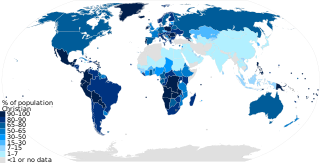
As of the year 2021, Christianity had approximately 2.4 billion adherents and is the largest religion by population respectively. According to a PEW estimation in 2020, Christians made up to 2.38 billion of the worldwide population of about 8 billion people. It represents nearly one-third of the world's population and is the largest religion in the world, with the three largest groups of Christians being the Catholic Church, Protestantism, and the Eastern Orthodox Church. The largest Christian denomination is the Catholic Church, with 1.3 billion baptized members. The second largest Christian branch is either Protestantism, or the Eastern Orthodox Church.

Religion has been a major influence on the societies, cultures, traditions, philosophies, artistic expressions and laws within present-day Europe. The largest religion in Europe is Christianity. However, irreligion and practical secularisation are also prominent in some countries. In Southeastern Europe, three countries have Muslim majorities, with Christianity being the second-largest religion in those countries. Ancient European religions included veneration for deities such as Zeus. Modern revival movements of these religions include Heathenism, Rodnovery, Romuva, Druidry, Wicca, and others. Smaller religions include Indian religions, Judaism, and some East Asian religions, which are found in their largest groups in Britain, France, and Kalmykia.

Christianity is the largest religion in Luxembourg, with significant minorities of non-religious people and adherents of other faiths.
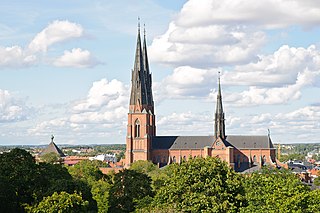
Religion in Sweden has, over the years, become increasingly diverse. Christianity was the religion of virtually all of the Swedish population from the 12th to the early 20th century, but it has rapidly declined throughout the late 20th and early 21st century.

Christianity is the most prevalent religion in the United States. Estimates from 2021 suggest that of the entire U.S. population about 63% is Christian. The majority of Christian Americans are Protestant Christians, though there are also significant numbers of American Roman Catholics and other Christian denominations such as The Church of Jesus Christ of Latter-day Saints, Eastern Orthodox Christians and Oriental Orthodox Christians, and Jehovah's Witnesses. The United States has the largest Christian population in the world and, more specifically, the largest Protestant population in the world, with nearly 210 million Christians and, as of 2021, over 140 million people affiliated with Protestant churches, although other countries have higher percentages of Christians among their populations. The Public Religion Research Institute's "2020 Census of American Religion", carried out between 2014 and 2020, showed that 70% of Americans identified as Christian during this seven-year interval. In a 2020 survey by the Pew Research Center, 65% of adults in the United States identified themselves as Christians. They were 75% in 2015, 70.6% in 2014, 78% in 2012, 81.6% in 2001, and 85% in 1990. About 62% of those polled claim to be members of a church congregation.

The dominant religion in Slovenia is Christianity, primarily the Catholic Church, which is the largest Christian denomination in the country. Other Christian groups having significant followings in the country include Eastern Orthodoxy and Protestantism (Lutheranism). Islam, Judaism and Hinduism are small minorities in Slovenia. About 18% of the population are either agnostic or atheist.

Estonia, historically a Lutheran Christian nation, is today one of the least religious countries in the world in terms of declared attitudes, with only 14 percent of the population declaring religion to be an important part of their daily life. This is thought to largely be a result of the Soviet occupation of Estonia in 1940, prior to which Estonia had a large Christian majority.
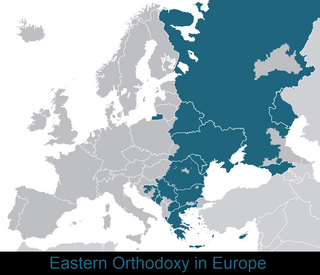
The Eastern Orthodoxy in Europe constitutes the second largest Christian denomination. European Eastern Orthodox Christians are predominantly present in Eastern and Southeastern Europe, and they are also significantly represented in diaspora throughout the Continent. The term Eastern Orthodox Europe is informally used to describe the predominantly Eastern Orthodox countries of Eastern Europe, as well as, Belarus, Bulgaria, Cyprus, Georgia, Greece, Moldova, Montenegro, North Macedonia, Romania, Russia, Serbia and Ukraine.
Based on the numbers of adherents, the Eastern Orthodox Church is the second largest Christian communion in the world, after the Roman Catholic Church, with the most common estimates of baptised members being approximately 220 million. The numerous Protestant groups in the world, if taken all together, substantially outnumber the Eastern Orthodox, but they differ theologically and do not form a single communion.

The Christian Union of Latvian Orthodox, generally known as the Old Believers, was a political party in Latvia in the inter-war period. It was led by Meletijs Kaļistratovs.

The Latvian Orthodox Autonomous Church, or All Holy Orthodox Church of Latvia, is a True Orthodox church in Latvia which is part of the Russian Orthodox Autonomous Church.
Irreligion in Latvia pertains to atheism, agnosticism, and lack of religious affiliation in Latvia. Irreligious thought in Latvian history is associated with national identity and a period of Communist rule. The irreligious make up a significant minority group in Latvia today, with 29% of Latvians identifying as irreligious.

